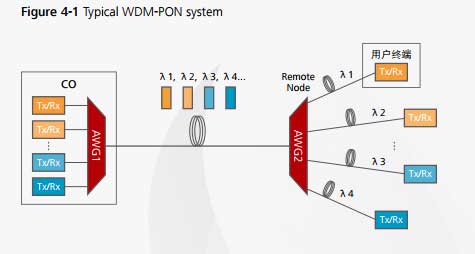WDM-PON Technology
A typical wavelength division multiplexing PON (WDM-PON) architecture is shown in Figure 4-1. The wavelength division MUX/DEMUX is employed in the ODN. In the example in Figure 4-1, array waveguide gratings (AWGs) are used to MUX and DEMUX wavelengths to or from ONUs. Signal transmission in WDM-PON is similar to that in the point to point GE (P2P GE). The difference between the two systems is that WDM-PON is based on the isolation of different wavelengths on the same optical fiber. Each ONU in WDM-PON exclusively enjoys the bandwidth resources of a wavelength. In other words, WDM-PON features a logical P2MP topology, as shown in Figure 4-2.
In the WDM-PON system in Figure 4-1, each port of the AWG is wavelengthdependent, and the optical transceiver on each ONU must transmit optical signals in a specified wavelength determined by the port on the AWG. Optical transceivers with specified wavelengths are called colored optical transceivers.
Colored optical transceivers introduce complexity in processes such as service provisioning and device storage. In addition, AWG components are sensitive to temperature. Therefore, WDM-PON has the following two major challenges.
Challenge 1: Addressing the real-time consistency between the wavelength of optical transceivers and the connecting AWG port.

Colorless optical source technology is used to resolve this issue. Colorless optical source solutions can be classified into tunable laser and seeded laser according to whether a seed source is involved. According to the source of the seed light, the solutions can be further defined as self-injection, external injection (including ASE seed light injection and array laser injection), and wavelength re-use.
Challenge 2: Addressing the real-time consistency between the wavelengths of the port on the local AWG (at the CO) and the port on the remote AWG. Wavelength alignment technology is used to resolve this issue. Wavelength alignment technology includes optical power monitoring and temperaturein sensitive AWG. Optical power monitoring was a solution proposed in the early stage of WDM-PON research. The recent solution to wavelength alignment is the temperature-insensitive AWG technology.

In addition to the aforementioned issues, other challenging factors to WDM-PON include the industry chain maturity, technology availability, cost, and insufficient bandwidth drive from the end users. It is not anticipated to have large scale deployment of WDM-PON in FTTH scenarios in the next 3–5 years. WDM-PON may, however, have fans in bandwidth-hungry and cost insensitive applications, such as FTTB/FTTbusiness and FTTMobile.
Source from HUAWEI: http://www.huawei.com/us/static/HW-077443.pdf